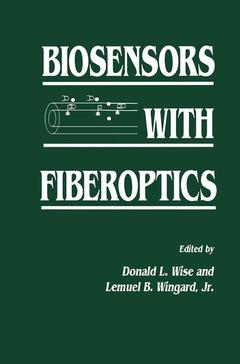Description
Biosensors with Fiberoptics, 1991
Contemporary Instrumentation and Analysis Series
Authors: Wingard Jr., Wise Donald L.
Language: English
Subject for Biosensors with Fiberoptics:
Publication date: 09-2012
370 p. · 15.5x23.5 cm · Paperback
370 p. · 15.5x23.5 cm · Paperback
Description
/li>Contents
/li>
Focusing on the rapidly increasing interaction between biotechnology and advanced fiberoptics/electronics, Biosensors with Fiberoptics emphasizes the three major phases of the developmental process from concept to marketplace: research, development, and applications.
With contributions by leading experts directly involved in key areas of this exciting, fast-paced field, the book describes novel biosensor technologies and such current and potential applications as: chemical sensing ? fluorescent labels ? evanescent-wave biosensors and immunosensors ? clinical applications ? immunoassay kinetics ? luminescence ? monitoring of environmental toxins.
Researchers and clinicians in a broad spectrum of disciplines will find Wise and Wingard's Biosensors with FIBEROPTICS an extremely practical, up-to-date reference text.
With contributions by leading experts directly involved in key areas of this exciting, fast-paced field, the book describes novel biosensor technologies and such current and potential applications as: chemical sensing ? fluorescent labels ? evanescent-wave biosensors and immunosensors ? clinical applications ? immunoassay kinetics ? luminescence ? monitoring of environmental toxins.
Researchers and clinicians in a broad spectrum of disciplines will find Wise and Wingard's Biosensors with FIBEROPTICS an extremely practical, up-to-date reference text.
Concepts, Biological Components, and Scope of Biosensors.- 1. Concept of a Biosensor.- 2. Biological Components.- 3. Transducers.- 4. Potential Applications.- References.- Chemical Sensing with Fiberoptic Devices.- 1. Introduction.- 2. Classification.- 3. Instrumentation.- 4. Analytical Characteristics.- 5. pH Sensors.- 6. Sensors for Anions.- 7. Sensors for Cations.- 8. Sensors for Gases.- 9. Sensors for Biochemicals.- 10. Sensors for Organic Compounds.- 11. Miscellaneous Sensors.- 12. Conclusions.- References.- Fluorescent Labels.- 1. Introduction.- 2. Fluorescence Excitation and Detection.- 3. Chemically Reactive Groups.- 4. Conclusions.- References.- Chemistry and Technology of Evanescent Wave Biosensors.- 1. Introduction.- 2. Why Fiberoptics?.- 3. Fiberoptic Fundamentals.- 4. Configurations for Fiberoptic Biosensors.- 5. Biochemical Architecture of Biosensors.- 6. Approaches for Improved Fiberoptic Biosensors.- 7. Summary.- Acknowledgments.- References.- Optical Characteristics of Fiberoptic Evanescent Wave Sensors Theory and Experiment.- 1. Introduction.- 2. Theory of Evanescent Wave Excitation and Detection of Fluorescence.- 3. Results Calculated from Theory.- 4. Results Based on Experiments.- 5. Summary and Conclusions.- 6. Symbols.- Acknowledgments.- References.- Evanescent Wave Immunosensors for Clinical Diagnostics.- 1. Introduction.- 2. Materials and Methods.- 3. Characterization of the Fiber as a Solid-Phase Surface-Isotopic Model.- 4, Fiberoptic Evanescent Wave Immunoassay (EWS).- 5. Summary and Discussion.- References.- Instrumentation for Cylindrical Waveguide Evanescent Fluorosensors.- 1. Introduction.- 2. Evanescent Waves.- 3. Importance of Numerical Aperture.- 4. Why Cylindrical Waveguides?.- 5. Optical System.- 6. Excitation System.- 7. Detection System.- 8. Filters.- 9. Optical Background.- 10. Sensitivity.- 11. Multiplex Operation.- 12. Applications.- Acknowledgments.- References.- Immunoassay Kinetics at Continuous Surfaces.- 1. Introduction.- 2. Abbreviations.- 3. The Continuous Surface.- 4. Effects of Diffusion at Continuous Surfaces.- 5. Optical Techniques Applied to Immunoassays at a Continuous Surface.- 6. Discussion and Conclusions.- Acknowledgment.- References.- Luminescence in Biosensor Design.- 1. Introduction.- 2. Bioluminescent Reactions.- 3. Immobilized Enzymes for Bioluminescent Analysis 2%.- 5. Bio-and Chemiluminescence Analysis with Fiberoptic Sensors.- 6. Conclusion and Future Trends.- References.- In Vivo Applications of Fiberoptic Chemical Sensors.- 1. Introduction.- 2. Critical Issues and Design Criteria.- 3. Oxygen Sensors.- 4. pH Sensors.- 5. Carbon Dioxide Sensors.- 6. Conclusions.- References.
© 2024 LAVOISIER S.A.S.



